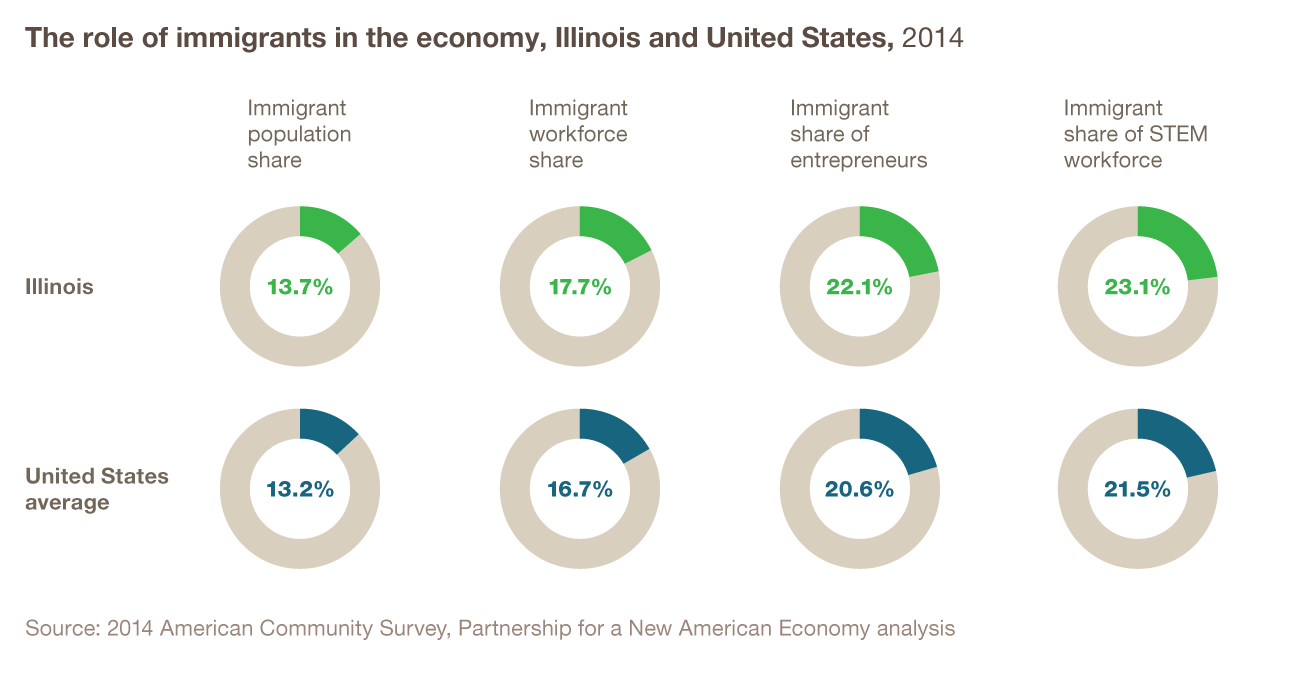
Immigration Reform Principles
Immigrants play an outsized role in Illinois’ economy. For the tech and innovation community, that role is even larger.
Though immigrants make up just 13 percent of Illinois’ population, they make up 18 percent of the state’s workforce, 22 percent of entrepreneurs, and 23 percent of the STEM workforce. In addition, more than 30 percent of startups from Illinois universities have a foreign-born founder or co-founder. In addition, immigrants or children of immigrants established more than 40 percent of current Fortune 500 companies.

Immigration Reform Principles
Startup Visa
To allow foreign-born entrepreneurs to stay in the country, grow their companies, and contribute to economic growth, the ISTC supports enacting a national startup visa. Under the current immigration system, foreign-born founders often face a difficult and uncertain path to residency in the United States. This path often requires entrepreneurs to apply for residence through the H1-B or other visa programs not principally designed for entrepreneurs.
A new startup visa program should clearly outline conditions that must be met for recipient entrepreneurs. These conditions may include investment, job creation, and revenue of the company over a set period of time. Clearly outlining these conditions and streamlining the application process for the visa would help ensure that entrepreneurs are allowed to stay in the country and contribute to economic growth.
H1-B
The H1-B visa program offers a three-year visa that can be extended up to six years for high-skilled workers, often in science and technology fields. To receive an H1-B, high-skilled foreign workers must be sponsored by an American company and enter a lottery system. Less than 100,000 H1-B Visas are granted annually.
H1-B visas allow American companies to attract and provide legal residence to high-skilled talent from around the world. The ability to provide residence to these workers allows American companies to attract quality talent and remain competitive in the global market. ISTC supports the H1-B program as a means for attracting talent to the United States. In addition, the H1-B visa system should be streamlined to help American companies attract top talent.
Deferred Action for Childhood Arrivals (DACA)
DACA is an immigration policy that allows the children of undocumented immigrants, brought to the United States before their 16th birthday, to receive a renewable two-year period of deferred action from deportation and eligibility for a work permit. ISTC supports this policy as an effort to allow undocumented immigrants to get an education, join the workforce and contribute to the economy without fear of deportation.
%
Population Share
%
Workforce Share
%
Share of Entrepreneurs
%
Share of STEM workers
Immigration Facts and Figures
- The immigrant workforce in Illinois is vital to the state’s economy. Illinois outpaces the nation in share of immigrants in the workforce, immigrants’ share of STEM degrees, and immigrant entrepreneurship.
- In Illinois, immigrants make up less than 15 percent of the population but account for more than 22 percent of entrepreneurs. The proportion of startups founded by immigrants is even higher at Illinois universities. Based on available information from our university partners, we estimate that at least 30 percent of university startups created over the past five years had a foreign-born founder or co-founder.
- Illinois extended its lead in STEM graduates compared with the country as a whole. In 2015, 29.1 percent of the state’s graduates earned STEM degrees compared with 27.0 percent nationally. (Roughly 36,000)
- In 2015, computer science degrees reached their highest level in Illinois in more than a decade, making the state the second-largest producer nationally. Illinois is also a national leader in the production of health degrees and STEM master’s degrees and is the fourth-leading producer of MBAs in the United States.
- In 2015, immigrants made up 17.7 percent of the workforce in Illinois, but accounted for 23.1 percent of STEM workers in the state and 22.1 percent of entrepreneurs 9 Illinois ranks above the national average on these measures, making the state and its higher education institutions a destination for students from around the world.
- In 2015, nearly one-quarter of non-health STEM degrees were awarded to international students (around 5,200 degrees). 10A staggering 68 percent of these degrees were at the master’s level. In fact, the number of non-health STEM master’s degrees awarded to international students has more than doubled since 2007.
- Overall, Illinois’ concentration of non-health STEM degrees awarded to international students was 48 percent higher than the national average in 2015. These findings continue to illustrate the vital role of international students in Illinois’ STEM talent supply.
